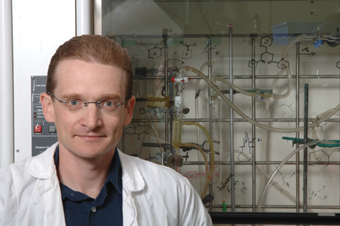Are you a journalist? Please sign up here for our press releases
Subscribe to our monthly newsletter:

Alternative energy promises a bright future thanks, in part, to dark paint. Our buildings, cars, ships and airplanes could one day be powered by a thin coat of special paint that will convert solar energy to electricity or fuel. Preference will be given to dark hues, which are better at absorbing sunlight. Thus a new Ferrari might, alas, come in black instead of red.
Making such futuristic energy concepts a reality will take radically new scientific approaches. “We haven’t made much progress in our use of energy,” says Dr. Boris Rybtchinski of the Weizmann Institute’s Organic Chemistry Department. “Our resources of oil and coal are limited, yet we continue to burn these fossil fuels and pollute the environment. In the meantime, the world’s demand for energy is soaring and the threat of global warming looms. There’s a huge gap between the enormity of the problem and the progress in finding alternative energy sources. We badly need fresh, creative ideas.”
Rybtchinski’s team is working on one such idea. He draws his inspiration from photosynthesis, the process by which plants and certain bacteria convert sunlight into chemical energy by employing an organic “paint” – chlorophyll. Certain artificial pigments are already more effective than chlorophyll, but combining them into functional systems is no simple matter. Rybtchinski seeks to create “well-connected” molecular systems that will harvest sunlight in clever ways intended to generate solar electricity and fuels.
Solar cells, which convert sunlight into electricity, are already available commercially; but their use is limited, in part, by their high cost and the difficulty of storing the energy, as these cells work only when the sun shines. The storage problem could be overcome by converting sunlight into chemical energy. In other words, fuels might be created using sunlight – just what photosynthesis achieves in nature.
Rybtchinski seeks to build artificial photosynthetic systems from cheap and readily available organic materials. Such systems might be able to produce various fuels from freely available ingredients – for example, hydrogen from water, or methanol from water and carbon dioxide. Solar paint would be a type of artificial photosynthetic system.
Rybtchinski believes that a better understanding of natural photosynthesis, combined with advances in organic chemistry and nanotechnology, can lead to innovative solutions in this field of research. In his lab, one doesn’t see the familiar panels or mirrors of solar installations. In fact, without an electron microscope one doesn’t see much of anything at all, as his solar energy nano-systems measure only several millionths of a millimeter.
To manufacture these systems, he takes a cue from yet another natural process – self-assembly – which governs the emergence of biological systems, from proteins to living organisms. Water plays a key structural role in self-assembly: Various biological molecules are either repelled or attracted to water molecules, and this property determines their position in living cells and tissues. With the help of an array of advanced technologies, Rybtchinski uses sophisticated molecular methods to exploit the hydrophobic – that is, “water-hating” – properties of certain organic molecules, manipulating them to self-assemble into efficient solar-energy-converting units.
In one of their projects, Rybtchinski’s group builds molecular “wires” that must perform three types of function, in rising order of complexity: moving photons while absorbing the energy of sunlight (a step occurring at the beginning of photosynthesis); moving electrons to convey an electric current in solar cells; and, finally, moving both electrons and protons to generate solar fuels.
In parallel, Rybtchinski collaborates with a number of other Institute scientists on creating hybrid solar conversion systems composed of organic molecules, catalysts and nano-particles. “In this work, we are solving basic science questions that are key to finding practical alternative energy solutions,” he says. “The need to find such solutions is what ultimately motivates us all.”
The long-term goal is not just to achieve plants’ efficiency at using sunlight – already a formidable challenge – but to overtake them. “Plants don’t run around the way we do, so our energy needs are vastly higher,” Rybtchinski explains. “Therefore, we need to generate much more energy and with greater efficiency.”
Born in Kiev, Ukraine, Dr. Boris Rybtchinski received a B.Sc. in chemistry from Kiev State University in 1992. He then immigrated to Israel and, in 1993, embarked on graduate studies at the Weizmann Institute under the guidance of Prof. David Milstein. After serving in the medical corps of the Israel Defense Forces, he earned his Ph.D. with distinction in 2002. He conducted postgraduate research at Northwestern University for three years and joined the Weizmann faculty in the fall of 2005. He has received a number of prestigious awards, including the Sir Charles Clore Prize. He lives in Tel Aviv with his wife, Revital, whom he met when both were students at Weizmann, and their son, Gal, several months old. He enjoys sports and reading history books.
Dr. Boris Rybtchinski’s research is supported by the Helen and Martin Kimmel Center for Molecular Design; the Alternative Energy Research Initiative; Mr. and Mrs. Yossie Hollander, Israel; the Robert Rees Applied Research Fund; Sir Harry Djanogly, CBE, UK; and Mr. and Mrs. Larry Taylor, Los Angeles, CA. Dr. Rybtchinski is the incumbent of the Abraham and Jennie Fialkow Career Development Chair.